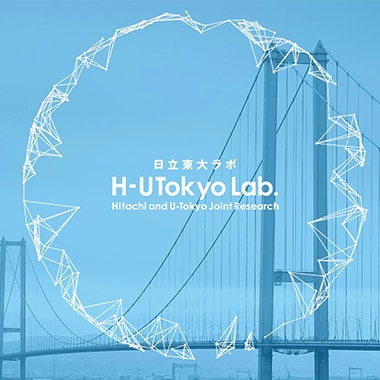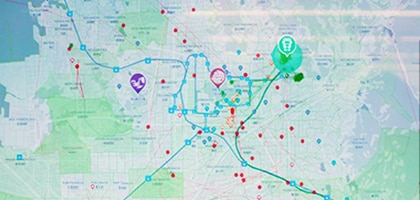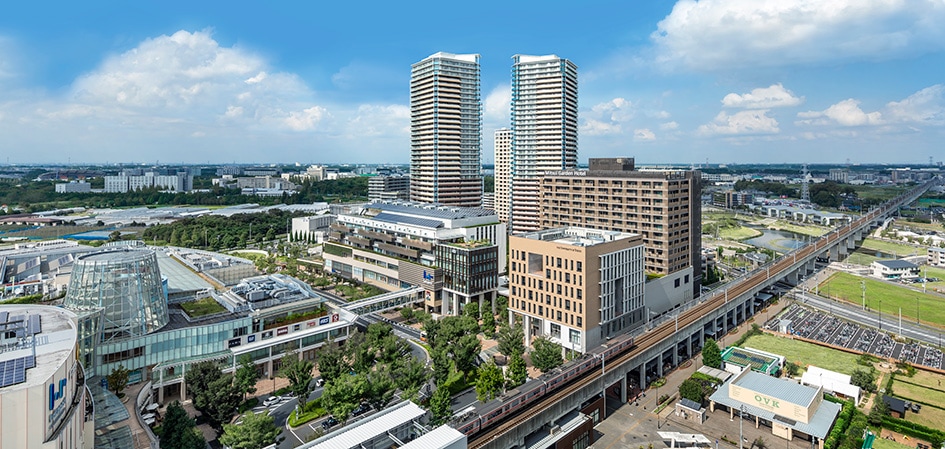Needs and wants of cities and communities are changing through the years. Residents’ lifestyles and sense of values are increasingly diversifying. Thus, innovation is crucial for the urban development industry in order to adapt to such societal changes. Essentially, rather than pursuing economy and efficiency, urban development should work toward realizing a society in which each individual can freely choose his or her own lifestyle while enjoying the values that promote happiness, such as comfort, convenience, prosperity, fulfillment, and health. One way of accomplishing this is the new approach to development of “smart cities” which involves participation of city residents.
Read to learn more: "Happiness research reveals 2 clues for future city development."
Recent years have seen a rising trend toward collaboration that goes beyond corporate frameworks. In an increasingly competitive environment, companies are struggling to come up with the innovation needed to find solutions to major challenges and to produce new value for customers using just their own resources. Concepts and policies related to "open innovation," which utilizes global resources, are spreading.
Recently, there has been much talk about the European paradigm, "Open Innovation 2.0." Representing an evolutionary step from previous forms, "Open Innovation 2.0" advocates the idea that all stakeholders, from customers to community residents, should be involved in producing innovation. Societal challenges are defined based on user perspectives and needs, and solutions to shared societal challenges are developed by multiple companies and communities. Innovation is driven by users themselves who actively provide their opinions and ideas.
This initiative provides good clues to the approach necessary for urban development of the future. Many cases exist of engaging in new urban development that targets regional and community revitalization. In some municipalities where such projects began as a city administrative initiative, the municipalities actually achieved such outcomes as increased tourist revenue and expanded working population. In addition to the outcomes targeted by the government, should their activities also lead to the happiness of those making their lives there, it could justify that advances have been made in urban development. To this end, city residents—the core of any community— who participate on their own in the "Open Innovation 2.0" initiative by bringing up even the minor community issues and concerns, will bring about a happy city to live in.


The city of Matsuyama in Ehime Prefecture, Japan, is one place where local government, academia, business, and city residents converged to participate in the frontlines of urban development.
In 2016, together with the University of Tokyo, Hitachi established the H-UTokyo Lab, a space for joint research aimed toward the achievement of a super-smart society. Combining Hitachi's extensive experience in infrastructure technology and IT with the University of Tokyo's cutting-edge research, this lab pursues research aimed at bringing about a society in which solutions to societal challenges and improvements to QoL (Quality of Life) coexist. Acting as a demonstration site for the Habitat Innovation Project carried out by the H-UTokyo Lab, Matsuyama is host to a joint research for a new type of urban development.
Matsuyama City has been working on community revitalization in accordance with its Sixth Matsuyama City General Plan since 2013. In one of its measures centered on city walks, efforts have been underway to achieve a comfortable and healthy city resident lifestyle.
The Habitat Innovation Project aims at further progress in Matsuyama's street planning by making use of data from different fields such as people-flow measurement, traffic volume, and consumer behavior. Based on the concept of data-driven urban planning, the project is oriented toward drafting urban plans based on data on the behavior of city residents. Previous urban planning had difficulty with deriving effective solutions because of complex interrelationships among many issues to solve. Verification requiring vast amounts of time and expenditures was a problem.

Cyber-PoC screen image
In dealing with this, Hitachi's proprietary methods and tools are being tested in a Proof of Concept with local communities.
When considering solutions for complex challenges and new services, it is necessary to plan a business that takes into account its feasibility and the profitability of all stakeholders, which is a complicated process. Taking a multi-angled approach to visualizing the various types of knowledge possessed by customer and partner stakeholders, Hitachi has systemized methods, IT tools, and spaces for the smooth implementation of collaborative creation. The result is a customer collaborative creation methodology called "NEXPERIENCE." Hitachi also developed a service business simulator called "Cyber-Proof of Concept" (Cyber-PoC), which is a tool that plays an important part in this methodology.
Based on data provided by city residents, this tool varies different parameters to simulate the effects of introducing infrastructure, facilities, and other new services. One feature of Cyber-PoC is that it provides visualization in the form a city map, a format that can be intuitively understood by anyone. By allowing people without expert knowledge to share ideas and conceptualizations for urban plans, Cyber-POC is expected to play a role in deepening discussions on urban development among city residents.

Cyber-PoC contributing to discussion
H-UTokyo Lab members conducted a simulation with Cyber-PoC, and have discovered that new initiatives such as expanding moveable transportation and increasing the number of rental cycle stations and parking lots may expand the range of travel of tourists inside Matsuyama City and potentially relieve congestion. Furthermore, building of new facilities such as parks and daycare centers as well as hosting of local events that meet residents’ potential needs with the help of cutting-edge technology. If city residents are able to directly experience how their voices are reflected in urban development, this will give rise to a cycle in which they take an active part in making local decisions and improvements in the community. It will draw out their sense of thinking independently, promoting their participation in urban development. In this way, Hitachi was able to provide opportunities for innovation that arises from actual residents living in the community.
Several cases of urban planning that use data exist overseas, as well. Those that, like Matsuyama, pursue urban development by taking city resident needs and challenges as the starting point for municipal governments, universities, and business to unite in producing innovation may be referred to as cutting-edge cases.
Another case of public, private, and academia coming together and acting as one in urban development is the city of Chiba's Kashiwa-no-ha Smart City. This city originally planned the smart city project based on two ideal scenarios: (1) the contribution to global environment protection by reducing CO2 emissions and (2) the building of an advanced model deployable to China and other emerging countries in southeast Asia.
It was at the time of the 2011 Great East Japan earthquake when Kashiwa-no-ha Smart City suffered interruptions to water supply and power outages. Residents pointed out a large gap between the ideal and reality. In response to this, Hitachi, which was participating in the public-private-academia partnership of the Smart City project, began taking considerations on measures with the active involvement of an employee who themselves were residents of Kashiwa-no-ha Smart City.
As a result, using the Kashiwa-no-ha AEMS (Area Energy Management System), jointly developed by Hitachi, Mitsui Fudosan, and Nikken Sekkei, Kashiwa-no-ha Smart City satisfied existing regulations and succeeded for the first time in going outside city boundaries to connect commercial facilities and ordinary residences with solar, storage battery, and other power generation facilities. Coming together as one, the city is now in the process of optimizing energy use. Because of the ability to efficiently control power generation, battery storage, and power interchange across the entire community, it is possible to provide a stable power supply even in a disaster. This also leads to energy savings and power rate reductions during normal times.
The key to the success of this initiative was close cooperation with the local community. The Kashiwa-no-ha HEMS (Home Energy Management System), which links with the Kashiwa-no-ha AEMS, permits residents to check the power usage and CO2 emissions of their home from their smartphones or personal computers and also to compare their numbers with those of other households or the city as a whole. Residents can receive specific advice from the system on how to conserve energy efficiently. Visualizing energy in this way provides for proposals on ways of living that are environmentally friendly while enhancing the spirit of participation of residents in energy conservation.
In addition, success in energy conservation comes with the benefit of being able to receive incentives in accordance with the reduction amount of CO2 emissions in each household. These can be used when participating in community events or going shopping in the area. This lets residents engage in energy conservation activities while also enjoying themselves.

View of Kashiwa-no-ha Smart City
The two cases introduced above all have the feature of having devised a mechanism for drawing out the ability of city residents to engage in independent thinking and enabling them to actively participate in urban development. As city residents are able to directly experience how their voices are reflected in urban development, they will become more positive about actively taking part as a member of the city. This will bring about a virtuous circle of further enhancement for urban appeal and new value creation.
In urban development, it is important to recognize that we are not just pursuing economies and efficiencies. With a view toward a human-centered urban development, Hitachi retains a policy of providing infrastructure that changes urban functions in accordance with the values of local residents and makes the city more attractive as people make their lives there. To achieve this will require collaborative creation that target active urban development, initiatives such as industry-academia-government collaboration, the installation of data platforms, and a user-friendly application development. Hitachi will continue to engage in various activities with all stakeholders to build happy, sustainable cities around the world.